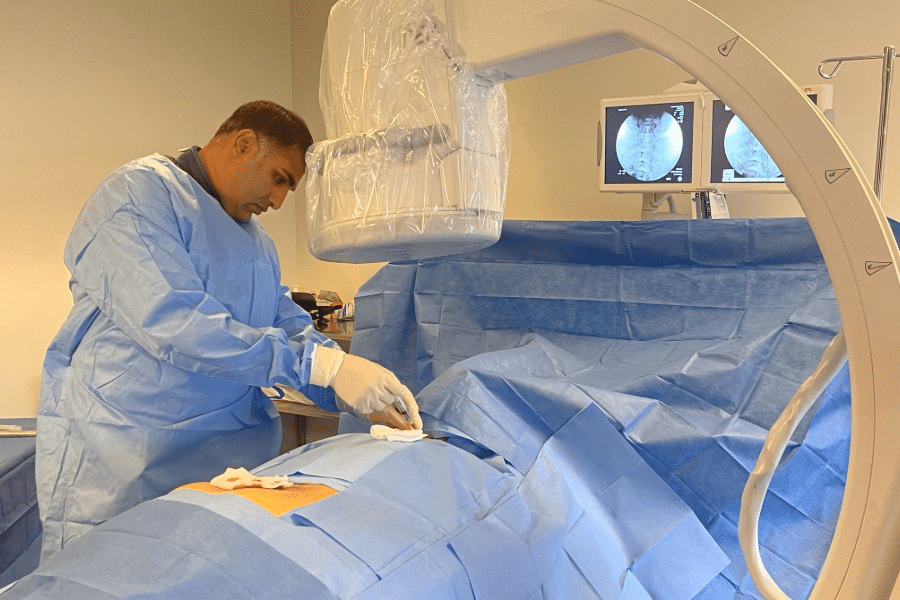
Top 10 Things You Need to Know About Stem Cell Therapy
Stem Cell Therapy Quick Facts:
- What is Stem Cell Therapy? Stem Cell Therapy is a non-surgical, outpatient procedure where we use your own reparative cells to naturally heal your body.
- What conditions does Stem Cell Therapy treat? Stem Cell Therapy is used for many spinal conditions, including degenerative disc disease, herniated discs, as well as other orthopedic and joint conditions like tendon or ligament tears or fractures that won’t heal.
- How do I know if I’m a candidate for Stem Cell Therapy? You can schedule a consultation and we can discuss your symptoms and review your imaging to decide together what course of treatment is right for you.
Stem cell therapy has become more mainstream and provides people with an alternative to surgery with minimal downtime. In fact, celebrities and athletes alike are sharing their personal experiences of overcoming pain and injury with this beneficial treatment. Cristiano Ronaldo, Max Scherzer, Charlie Sheen, and even Madonna have all had positive results with stem cell therapy that have gotten them back to their respective physically demanding professions while avoiding the downtime that comes with surgery.
While there is a lot of buzz about this modern pain solution to major joints and spine conditions, there is also a lot of misinformation out there about it. It’s important to find information from a credible source and get all the facts before making a decision as to whether this is right for you.
As a seasoned specialist in the revolutionary field of regenerative medicine, I have been performing stem cell therapy and other regenerative medicine procedures for over a decade. During this time, my patients have come to me with an array of questions and myths they are looking for me to help them sort through and set straight. While I continue to educate my patients about the array of regenerative medicine treatment options (including stem cell therapy, platelet-rich plasma PRP, and microfragmented adipose (fat) injections), I can see where it can be overwhelming with so much information out there.
Here are the Top 10 things you need to know about stem cell therapy, from the 2022 Face of Regenerative Medicine, Dr. Niteesh Bharara.
1. What is Stem Cell Therapy?
Stem cell therapy is a non-surgical, outpatient procedure that utilizes the body’s natural healing process. This safe and effective treatment works to:
- Rebuild damaged tissue
- Effectively heal injuries
- Eliminate pain
By taking your body’s own stem cells directly from your body’s bone marrow, and then injecting them into the area of your body that is injured or damaged, I am able to create a natural environment for healing.
2. What conditions and areas of the body does stem cell therapy treat?
Stem cell therapy can be used for the relief of most orthopedic conditions and common spinal conditions. While we are one of the only practices in Virginia to use stem cell therapy to heal discs in the spine, our regenerative medicine specialists have pioneered this safe and effective solution for most orthopedic conditions. Most commonly, stem cell therapy is used for:
- Spinal conditions include degenerative disc disease, herniated discs, spinal facet pain, pinched nerves, and sacroiliac (SI) joint pain.
- Osteoarthritis of the joints including the knee, hip, shoulder, and ankle joints.
- Partial rotator cuff tears
- Persistent tendon tears such as tennis elbow, plantar fasciitis, quadriceps, and patellar tendon tears.
- Muscular tears
- Cartilage tears in the knee (meniscus)
- Non-healing bone fractures
3. Should I have surgery or stem cell therapy?
People choose the route of stem cell therapy as a viable option to delay surgery or even avoid surgery altogether. By targeting the underlying source of pain, stem cell therapy can increase your function and mobility without surgery or medication. It can also reduce your recovery time compared to surgical options. The recovery timeline between surgery and stem cell therapy is incomparable. Stem cell therapy is always performed as an outpatient procedure with the complete process taking about three hours from procedure prep through to when patients are discharged to go home.
4. How long does stem cell therapy last?
This answer depends on the person’s own pathology, the part of the body the treatment is being performed on, and how damaged that area is. For many patients, this is the last treatment they’ll ever need for their injury. It allows them to avoid surgery, and get back to their active life. For others, if there is extensive damage, or their body is slow at healing, it might take a few rounds of stem cells to get them back to pain-free.
5. What makes a good candidate for stem cell therapy?
Every person’s situation is unique, that is why our nationally-recognized specialists will determine whether or not stem cell therapy is the best treatment option for your condition. During your comprehensive consultation, your doctor will spend quality time with you to understand your overall health, any underlying medical conditions, lifestyle, job requirements, and expectations. By doing this, we can lay out your customized treatment plan, and in some cases combine regenerative therapies to achieve the most optimal outcome for you.
6. Is stem cell therapy painful?
Stem cell therapy procedures are not very painful at all. I numb the area to make it as comfortable as possible. And in the event a patient is feeling discomfort, I will add additional numbing medicine to the area to contain it. Once the treatment is over, most patients are just using over-the-counter pain medicine for a day or two.
7. Is stem cell therapy approved by the FDA?
Stem cell therapy is FDA exempt. The FDA does not regulate the treatment we perform because we are using the patient’s own bone marrow and blood to perform it. Now if this treatment was performed by using someone else’s bone marrow, then it would fall under the FDA regulation.
8. What type of stem cells are used for stem cell therapy?
We use your own stem cells for your stem cell therapy procedure. We do not use embryonic stem cells or stem cells from another patient. Your own stem cells are taken directly from your body’s bone marrow, and then precisely placed into the area of injury using image guidance. Your bone marrow’s stem cells are called Mesenchymal Stem Cells, and are known as the body’s ‘repairmen.’ They have the ability to repair muscle, bone, cartilage, and tendons. It is important to understand that these stem cells do not have the ethical concerns that arise with the use of embryonic stem cells.
9. How soon can I get back to physical activity after stem cell therapy?
While some patients can feel relief almost right away, we typically clear patients around 4-6 weeks for physical activity. With this timeline, the body will have had adequate time to heal and regenerate healthy cells for the damaged area. That being said, there are many milestones you’ll achieve before 6 weeks post-treatment. You’ll be walking within 48 hours, you’ll have a full range of motion almost immediately, and you’ll be back at work within the first few days post-treatment.
10. Where can I safely receive stem cell therapy?
Not all doctors and practices are the same. You want to find a medical practice that has a doctor who is highly trained and skilled at performing stem cell therapy. Your regenerative medicine specialist should understand the different types of regenerative medicine procedures and should be able to offer a unique and customized treatment plan for you.
Also, make sure they are using your own cells, and that some type of imaging tool is being used to place your stem cells into the affected area. At VSI we offer just that — we go through extensive training to perform stem cell therapy, and we are performing them daily in our state-of-the-art outpatient treatment center. We use fluoroscopy and ultrasound imaging to make sure your own stem cells, taken that same day from you, are correctly placed back into your body’s affected area. By doing this, you have the best rate of success because a healthy environment has been created for damaged tissue to start growing and healing effectively.
You deserve the best care when receiving stem cell therapy, and we’ve got just that. We have the nation’s top specialists all working together in one state-of-the-art facility while providing the most advanced and unique treatments. Schedule an in-office or virtual consultation today to avoid surgery and resolve your pain.
Topics covered
About the Author
Featured Resources
Insights to Achieve a Pain-Free Life



